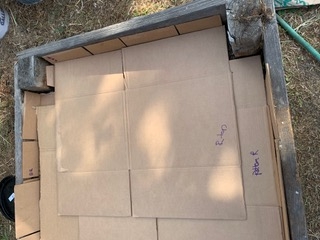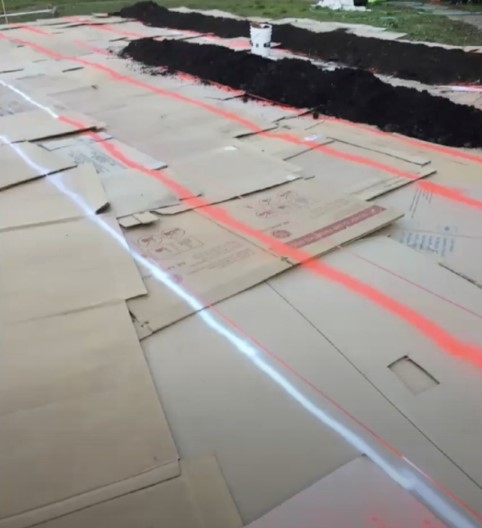As you look out at your very soggy garden on these winter days, it is normal to dream of future projects. Perhaps you want to revive that old, raised bed with the low soil level. Or you would like to have an easier job of weeding under your rose bushes. Or maybe you want to get rid of that big lawn once and for all.
You can start preparing now to revitalize your soil without having to work on your hands and knees. Sheet composting (also known as lasagna composting) is one way to tackle all those projects.
First, gather your materials or at least plan where to gather them. Whatever your project, you will need cardboard. For a small project, smaller boxes will work. If you are planning on eliminating a lawn, appliance or bicycle boxes will make the job faster. Avoid boxes with shiny ink and be sure to remove any plastic tape.
Now gather compostable materials from your kitchen and garden. You will need both “browns” and “greens.” Brown materials are high in carbon and include dried leaves, shredded newspaper, straw (not hay, which has seeds), dried lawn clippings and even rice hulls (available from feed stores). Green materials are high in nitrogen and include chopped kitchen waste, coffee grounds, tea bags, fresh lawn clippings and garden trimmings. You can freeze kitchen waste if you need to gather it over time.
Do not add weeds with seed heads, perennial weeds with deep tap roots, rose clippings or diseased plant material. Also avoid dairy products, meat and oily foods (including that leftover salad with dressing) as they attract animals. Another no: waste from carnivorous pets such as cats and dogs.
To revitalize a raised garden bed with sheet composting, begin by cutting back any weeds or grass. Wet the soil, then add a layer of cardboard to block the sun from getting to any weed seeds. Top the cardboard with alternating, not-too-thick layers of the brown and green materials, spraying each layer with water. Like making lasagna! You may want to put a piece of burlap on top or perhaps some straw to keep things in place. Do you have places in your garden where weeds return with a vengeance, or where it is difficult to get to the weeds? These areas are ideal for sheet composting. First lay down your cardboard. (Landscape staples can be helpful in holding cardboard in place.) Then you can use the same layering technique as for raised beds, or you can simplify by placing finished compost, purchased from a nursery or municipal composter, on top of the wet cardboard. These layers will prevent weeds from germinating, and after the cardboard decomposes your soil will be much easier to work.
If you want to transform a lawn into a garden site, first cut the grass short. At my house, I used large cardboard boxes from an appliance store, with landscape staples to hold the cardboard in place. A friend helped move compost into place with a wheelbarrow. I spray-painted lines to show where to put the compost and then filled in with straw for walkways. It was a big job, but no pulling of weeds was required.
I wish I could tell you that sheet composting permanently eliminates weeds, but that would be untrue. However, if your soil is naturally hard and full of clay, like mine, you will find that sheet composting transforms it.
Last year, I had trouble seeing where the path was in an area where a larger plant had been removed. With a shovel, it was easy to tell. Even four years after the sheet composting, the area that had received the lasagna treatment was much easier to dig than the pathway. Sheet composting is a great way to create a new garden site, or improve the soil in an existing site, without backbreaking shovel work.
For information about upcoming compost workshops in Napa County, watch for a flyer from your waste-management company or visit the UC Master Gardeners of Napa County website. Library Talk: UC Master Gardeners of Napa County and Napa Library will host a talk on Thursday, March 7, on “Agaves - More Than Tequila and Century Plants” from 7 pm to 8 pm via Zoom. Learn more about adding these deer-proof, beautiful and low-maintenance plants to your garden. Register Hereto receive the free Zoom link. Workshop: Join UC Master Gardeners of Napa County for “Spring Into Summer Vegetable Garden” on Saturday, March 9, from 8 am to 5 pm. Plan your vegetable growing for the warm weather ahead. Topics include soil prep, fertilizing, managing pests, irrigation, and planting schedules. This is a hands-on workshop and registration is required. Help Desk: The Master Gardener Help Desk is available to answer your garden questions on Mondays and Fridays from 10 a.m. until 1 p.m. at the University of California Cooperative Extension Office, 1710 Soscol Avenue, Suite 4, Napa. Or send your questions to mastergardeners@countyofnapa.org. Include your name, address, phone number and a brief description.

